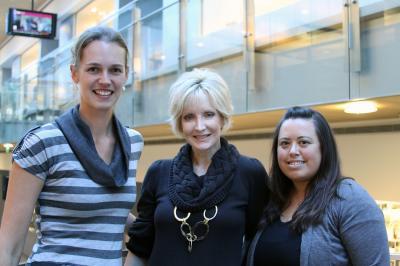In a new paper, a team reports their recent work examining the effects of spaceflight on microbial pathogens - in this case infectious disease potential of the fungal pathogen, Candida albicans, the first global gene expression profiling and phenotypic characterization of a fungal pathogen during spaceflight.
Candida is a type of fungus—a eukaryotic microorganism. It is often found in soils and water and is ubiquitous in man-made environments, including the space shuttle and International Space Station. C. albicans is part of the normal flora of human beings, present on the skin, in the oral cavity, and in the gastrointestinal, urogenital and vaginal tracts.
Although it exists in 80 percent of the human population as an unobtrusive guest, C. albicans is an opportunistic pathogen, turning hostile under particular conditions. This process involves a transition from unicellular, yeast-like cells to a multicellular, filamentous and invasive form, triggered by specific environmental cues.
The study reports the differential regulation of 452 genes in spaceflight-cultured C. albicans, compared to fungal cells cultured under otherwise identical ground-based conditions. The expression of a wide variety of functionally diverse gene families was altered, including those regulating cell aggregation and budding, biofilm formation and resistance to pathogenesis-related stresses and antifungal drugs.
In agreement with the gene expression data, C. albicans demonstrated enhanced cell aggregation and a differential budding pattern in response to growth under microgravity conditions.
Ten most represented functional categories affected by growth of C. albicans in spaceflight conditions. The top ten of functional categories was determined by calculating (A) the ratio of the number of genes in category X to the total number of genes in the genome assigned to category X, and (B) the ratio of the number of genes in category X to the total number of genes differentially regulated by spaceflight.
The pathogen in its transformed state poses a significant infectious disease risk. It is a particularly tenacious foe in immunocompromised individuals, like those undergoing treatment for AIDS, chemotherapy or bone marrow transplantation, and can also cause disease in normal individuals taking antibiotics. The unchecked fungus can cause superficial mucous membrane infections (such as thrush) but also sometimes leads to systemic candidiasis, a potentially lethal condition.
In the current study, fungal cell cultures of C. albicans were flown aboard the space shuttle Atlantis, on NASA Space Shuttle Mission STS-115. C. albicans is a considerable concern during spaceflight missions, as the harsh and rigorous environment encountered by astronauts weakens their immune system, leaving space voyagers especially vulnerable. Indeed, such infections are not uncommon among flight crews and are of grave concern during longer missions.
While the phenotypic changes induced by spaceflight were consistent with features associated with increased virulence, the spaceflight C. albicans cultures did not exhibit heightened virulence when mice were exposed through i.p. injection. Further research is required to conclusively determine if spaceflight alters C. albicans virulence. Of particular importance is to assess whether the compromised immune system of astronauts could influence their susceptibility to C. albicans infecti on. The propensity of C. albicans to cause mucosal and deep tissue infections, coupled with the immunosuppressive condition characteristic of flight crew members, make a more thorough evaluation of virulence potential imperative.

From left to right: Lead author Aurélie Crabbé, Cheryl Nickerson and Jennifer Barrila of the Biodesign Institute at Arizona State University. Credit: Photo: Anais Bon for the Biodesign Institute at Arizona State University.
Credit and link: doi:10.1371/journal.pone.0080677
They say that the new research is the first to demonstrate global regulation induced by spaceflight in a eukaryotic pathogen—an essential step in disease-risk assessment. Results from this research will also serve to direct future spaceflight experiments and will allow scientists to further enhance their understanding of the response of microorganisms to the microgravity environment. The potential role of transcriptional regulators like Cap1, as well as other characteristics associated with a virulence phenotype are fertile ground for future study.
"Our research has important medical implications for spaceflight safety and may also shed light on the as-yet poorly understood mechanisms of pathogen infection and disease trajectory, both in space and on earth," according to lead author Aurélie Crabbé of Arizona State University.
"This research serves as a springboard to inform ongoing spaceflight studies of Candida albicans, as well as to put our ground-based studies into context," says co-author Sheila Nielsen-Priess, of the Department of Immunology and Infectious Disease, Montana State University. "The ultimate goal is to achieve a better understanding of how C. albicans causes infection, in space or here on Earth. Studying the yeast in the extreme environment of microgravity provides an additional window through which to view the cellular response and to better understand its behavior."
Among the more remarkable findings of this research are that pathogens globally alter their gene expression and disease-related properties during spaceflight culture in ways that cannot be observed during traditional experimental approaches, where the force of gravity can mask key responses.
One of the key factors influencing gene expression and physiological alterations to pathogenic cells in microgravity—both prokaryotic and eukaryotic—is a property known as fluid-shear. This refers to the level of abrasion caused by extracellular fluids flowing over cell surfaces.
Under microgravity conditions, fluid-shear is reduced, triggering changes in gene expression and associated phenotypic alterations. Such changes may in fact mimic conditions microbes encounter on earth, for example, regions in the human body where fluid-shear is similarly reduced, including in the gastrointestinal, urogenital and respiratory tracts.





Comments